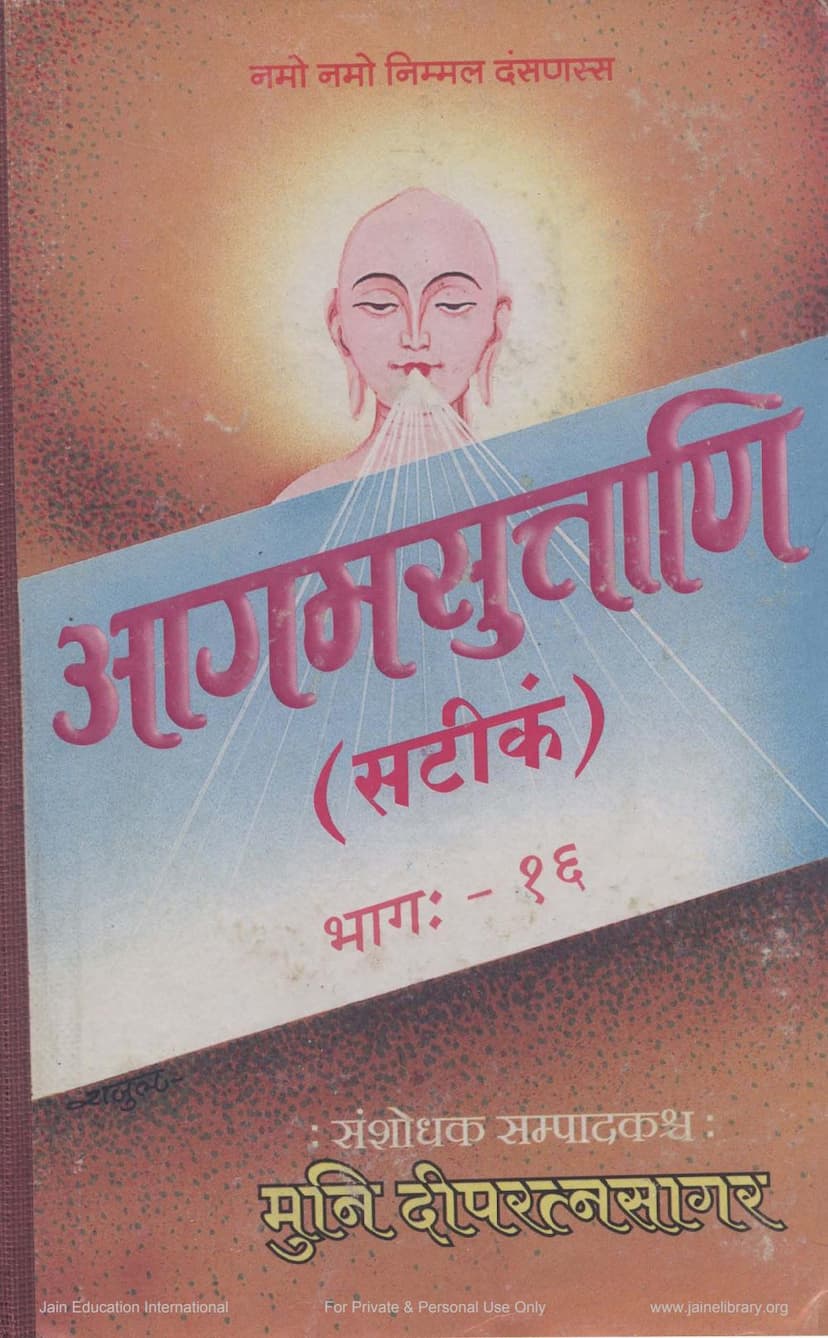Agam Suttani Satikam Part 16 Nishitha
Added to library: September 1, 2025

Summary
This document is the 16th part of the Agam Suttani Satikam, titled "Nishitha". Authored by Muni Deepratnasagar, it is published by Agam Shrut Prakashan. This particular volume covers sections (Udeshakas) 7 through 13 of the Nishitha Chhedasutra.
The text is a commentary (Satikam) on the Nishitha Chhedasutra, a foundational text in Jainism that outlines the rules and conduct for monks. This part of the commentary focuses on specific transgressions and prohibitions for monks, particularly concerning interactions with the outside world, the handling of materials, and various behaviors deemed inappropriate for ascetics.
Key Themes and Content Covered in Part 16 (Udeshakas 7-13):
The detailed content list provided in the "Vishayanukram" (Table of Contents) within the document reveals a wide range of topics discussed in these Udeshakas, focusing on the strictures and guidelines for Jain monks. These include:
-
Rules of Conduct related to Living and Movement:
- Prohibitions regarding sexual desire and its manifestations (Udeshakas 7 & 8).
- Regulations concerning monks' interactions with women, including prohibitions on traveling with them, studying with them, or engaging in conversations (Udeshakas 8 & 10).
- Guidelines on appropriate conduct in various locations like gardens, villages, and royal residences when interacting with the opposite sex (Udeshakas 8 & 10).
- Prohibitions on accepting or using certain types of items, particularly those associated with worldly pleasures or potentially harmful (Udeshakas 7 & 10). This includes prohibitions related to metal objects, jewelry, clothing made from specific materials, and even the use of certain parts of animals.
- Strict rules about what constitutes prohibited behaviour in relation to living beings (Jiva), including the prohibition of harming or capturing sentient beings (Udeshakas 7 & 12).
- Prohibitions related to the accumulation and use of wealth, royal patronage, and interactions with the public (Udeshakas 9 & 10).
-
Dietary and Usage Restrictions:
- Detailed regulations on food and drink, including prohibitions on consuming certain items, the conditions under which food can be accepted or refused, and rules regarding the preparation and consumption of food (Udeshakas 7, 9, 10, 11, 12, 13). This covers prohibitions on uncooked food, food mixed with forbidden substances, and specific rules for consuming food during different times of the day or under various circumstances.
- Rules regarding the use of clothing, bedding, and other essential items, with emphasis on simplicity and detachment (Udeshakas 7 & 11).
- Prohibitions related to the use of specific materials like metals, animal products, and certain types of clothing (Udeshakas 7 & 11).
-
Spiritual and Ethical Conduct:
- Guidelines on respecting religious rules and avoiding actions that could be considered disrespectful or lead to spiritual downfall (Udeshakas 7, 10, 11, 12, 13). This includes prohibitions on imitating or associating with non-Jain ascetics or householders, and avoiding acts that could be misconstrued as contrary to Jain principles.
- Emphasis on maintaining purity of conduct and thought, avoiding attachment, and adhering to the prescribed path (Udeshakas 7, 10, 11, 12, 13). This covers topics like avoiding anger, pride, deceit, and greed.
- Regulations concerning the proper way to handle and use essential items, avoiding waste or misuse (Udeshakas 7 & 11).
- Detailed rules regarding the conditions under which monks can travel, stay in specific places, and interact with the public, including the prohibition of traveling alone or with unsuitable companions (Udeshakas 8 & 11).
- Guidelines on how to behave in the presence of royalty, common people, and during auspicious or inauspicious events (Udeshakas 9 & 10).
- Specific prohibitions concerning the use of certain tools, materials, and even actions related to the body, such as grooming, dressing, and bathing (Udeshakas 7 & 11).
- The commentary also delves into the concept of "anana" (prohibited or regulated actions) and "pratikramana" (repentance or confession) for various transgressions.
Commentary Style:
The text includes a commentary, likely a "Churni" (a detailed explanation often in prose) and potentially "Bhashya" (a more interpretative commentary), as indicated by the presence of Muni Deepratnasagar as the "Sanshodhak Sampadak" (Researched and Edited by). The commentary aims to clarify the meaning and implications of the sutras, providing detailed explanations and context for each rule.
Overall Purpose:
The Nishitha Sutra, and by extension this commentary, serves as a comprehensive guide for Jain monks to live a life of strict adherence to the principles of non-violence (Ahimsa), non-attachment (Aparigraha), and truthfulness (Satya), even in the most minute details of daily life. The text emphasizes meticulous attention to conduct to prevent even the slightest spiritual transgression, ensuring the monk's progress towards liberation (Moksha).
In essence, this volume of "Agam Suttani Satikam" provides an in-depth exploration of the rigorous ethical and behavioral codes that govern the life of a Jain monk, emphasizing the importance of vigilance in every action and thought.